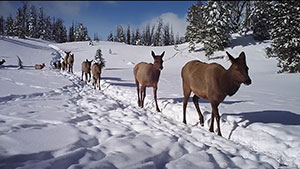
Contact Us
Institutional Communications
Bureau of Mines Building, Room 137
Laramie, WY 82071
Phone: (307) 766-2929
Email: cbaldwin@uwyo.edu

Rocky Mountain Elk Foundation Gift to UW Supports Mapping of Big
Published December 16, 2021

A migrating cow elk and her calf lead a group of elk during migration to winter range
in the greater Yellowstone ecosystem in Wyoming. The Rocky Mountain Elk Foundation
has recently donated to a major effort to map elk migration corridors across the western
United States. (Gregory Nickerson and Travis Zaffarano Photo)
A state and federal effort to map big-game migration corridors in the American West received a major grant from the Rocky Mountain Elk Foundation (RMEF), one of the country’s largest big-game conservation organizations. The gift will help map iconic elk migrations across the region, stimulating public and private conservation to benefit wildlife populations.
RMEF donated $180,000 to the University of Wyoming, where the U.S. Geological Survey’s Wyoming Cooperative Fish and Wildlife Research Unit leads an American West migration corridor mapping team.
The project is a collaboration among the U.S. Geological Survey (USGS) and the wildlife agencies of 11 Western states, assembled in response to Secretarial Order 3362 issued by then-Department of the Interior Secretary Ryan Zinke in 2018. The mapping and conservation of migration corridors remains a top priority for current Secretary of the Interior Deb Haaland.
“The corridor maps give us a great tool to pinpoint our on-the-ground conservation efforts,” says Blake Henning, chief conservation officer for RMEF. “Conserving elk migrations is a priority for RMEF and its members, and detailed maps are critical to that effort.”
The RMEF grant will expand the migration mapping program to include outreach and collaboration with 11 public land states in the American West -- Arizona, California, Colorado, Idaho, Montana, Nevada, New Mexico, Oregon, Utah, Washington and Wyoming. The project specifically supports mapping migrations of 17 new elk herds for the third volume of “Migration Corridors of the Western United States,” a report set for publication in December 2022.
The mapping team is analyzing the data to delineate and map migration corridors so they can be made available for conservation planning. For decades, state wildlife agencies have collared and monitored migratory herds, collecting millions of GPS locations of their seasonal movements.
The first report, “Migration Corridors of the Western United States, Vol. 1,” was published in 2020 and has attracted substantial public interest. A second volume will be published in February 2022.
“For years, RMEF has partnered with state fish and wildlife agencies to fund collaring studies to track elk movements throughout the western U.S.,” says Matt Kauffman, the USGS researcher and UW professor who leads the effort out of the Wyoming Cooperative Fish and Wildlife Research Unit. “Their support of corridor mapping is a clear sign of RMEF’s ongoing commitment to sustaining elk migrations across their range.”
Compiling an archive of migration maps is a priority for state and federal partners because the mapping helps implement conservation solutions across the West. Private ranches and land trusts that conserve open space increasingly have access to funds from the U.S. Department of Agriculture’s Natural Resources Conservation Service to enhance migration habitat, establish voluntary conservation easements to prevent subdivision, retrofit fences and remove weeds.
Prompted by Secretarial Order 3362, most Western states have action plans to conserve big-game corridors. The current administration’s Conserving and Restoring America the Beautiful initiative -- an effort to conserve 30 percent of lands and water by 2030 -- further prioritizes the conservation of fish and wildlife habitats and corridors.
The recently passed Infrastructure Investment and Jobs Act includes $350 million for wildlife-roadway crossing structures, which could build on past successes such as the Trappers Point under- and overpasses near Pinedale that help mule deer and pronghorn migrations across a busy highway.
“This momentum around migration corridors is great to see,” Kauffman says. “It elevates the importance of the work to map corridors, which is the science needed to assure we make conservation investments in the right places.”
Funding provided by RMEF will expand the collaboration and outreach between the USGS and state wildlife agencies and accelerate migration mapping and corridor conservation as the West continues to grow.
The Western corridors mapping team based at UW is a collaborative project of the USGS Ecosystems Mission Area and the Cooperative Fish and Wildlife Research Units Program, which work with state and federal partners to provide actionable science to monitor and manage the nation’s fish and wildlife populations.
Contact Us
Institutional Communications
Bureau of Mines Building, Room 137
Laramie, WY 82071
Phone: (307) 766-2929
Email: cbaldwin@uwyo.edu

